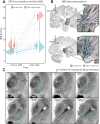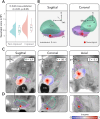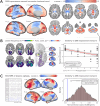This is a preprint.
A human brain network linked to restoration of consciousness after deep brain stimulation
- PMID: 39484242
- PMCID: PMC11527079
- DOI: 10.1101/2024.10.17.24314458
A human brain network linked to restoration of consciousness after deep brain stimulation
Update in
-
A human brain network linked to restoration of consciousness after deep brain stimulation.Nat Commun. 2025 Jul 21;16(1):6721. doi: 10.1038/s41467-025-61988-4. Nat Commun. 2025. PMID: 40691170 Free PMC article.
Abstract
Disorders of consciousness (DoC) are states of impaired arousal or awareness. Deep brain stimulation (DBS) is a potential treatment, but outcomes vary, possibly due to differences in patient characteristics, electrode placement, or stimulation of specific brain networks. We studied 40 patients with DoC who underwent DBS targeting the thalamic centromedian-parafascicular complex. Better-preserved gray matter, especially in the striatum, correlated with consciousness improvement. Stimulation was most effective when electric fields extended into parafascicular and subparafascicular nuclei-ventral to the centromedian nucleus, near the midbrain-and when it engaged projection pathways of the ascending arousal network, including the hypothalamus, brainstem, and frontal lobe. Moreover, effective DBS sites were connected to networks similar to those underlying impaired consciousness due to generalized absence seizures and acquired lesions. These findings support the therapeutic potential of DBS for DoC, emphasizing the importance of precise targeting and revealing a broader link between effective DoC treatment and mechanisms underlying other conscciousness-impairing conditions.
Keywords: DBS; arousal; centromedian; disorders of consciousness; parafascicular; thalamus.
Conflict of interest statement
COMPETING INTERESTS AELW, MR, HF, FLWVJS, JT, SBS, JL, MMJC, KB, MUF, RJ, JEI, PWC, DF, ADB, BLE, and DC have no competing interests to report. MDF has intellectual property on the use of brain connectivity imaging to analyze lesions and guide brain stimulation, has consulted for Magnus Medical, Soterix, Abbott, Boston Scientific, and Tal Medical, and has received research funding from Neuronetics. AH reports lecture fees for Boston Scientific and is a consultant for Neuromodulation and Abbott. JDR has received past consulting payments from Medtronic, Corlieve, ClearPoint, Medtronic, and NeuroPace, and currently consults for Turing Medical.
Figures





References
-
- Giacino JT, Katz DI, Schiff ND, et al. Practice guideline update recommendations summary: Disorders of consciousness: Report of the Guideline Development, Dissemination, and Implementation Subcommittee of the American Academy of Neurology; the American Congress of Rehabilitation Medicine; and the National Institute on Disability, Independent Living, and Rehabilitation Research. Neurology 2018;91(10):450–460. - PMC - PubMed
-
- Kondziella D, Bender A, Diserens K, et al. European Academy of Neurology guideline on the diagnosis of coma and other disorders of consciousness. Eur J Neurol 2020;27(5):741–756. - PubMed
-
- Fischer D, Edlow BL. Coma Prognostication After Acute Brain Injury: A Review. JAMA Neurol 2024. - PubMed
-
- Hassler R, Ore GD, Bricolo A, et al. EEG and clinical arousal induced by bilateral long-term stimulation of pallidal systems in traumatic vigil coma. Electroencephalogr Clin Neurophysiol 1969;27(7):689–690. - PubMed
Publication types
Associated data
Grants and funding
- DP2 HD101400/HD/NICHD NIH HHS/United States
- R01 NS127892/NS/NINDS NIH HHS/United States
- RF1 AG080371/AG/NIA NIH HHS/United States
- R01 AG070988/AG/NIA NIH HHS/United States
- R01 MH113929/MH/NIMH NIH HHS/United States
- RF1 MH123195/MH/NIMH NIH HHS/United States
- R21 NS123813/NS/NINDS NIH HHS/United States
- R01 MH130666/MH/NIMH NIH HHS/United States
- R21 MH126271/MH/NIMH NIH HHS/United States
- UH3 NS109557/NS/NINDS NIH HHS/United States
- R01 NS138257/NS/NINDS NIH HHS/United States
- UM1 NS132358/NS/NINDS NIH HHS/United States
- UM1 MH130981/MH/NIMH NIH HHS/United States
LinkOut - more resources
Full Text Sources
